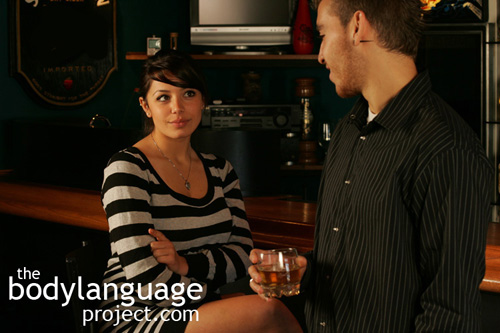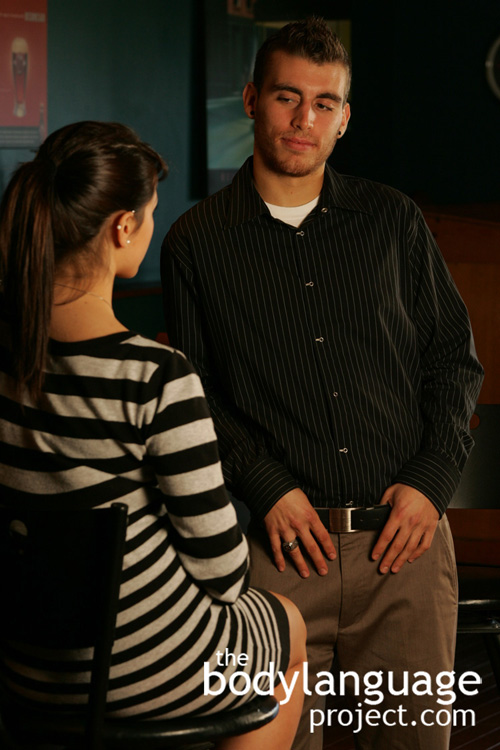Body Language of F%$k Me Eyes
Synonym(s): N/A
Description: A predator sexual eye pattern best accomplished by women who indicate to men that they wish to have sex with them. The eyes are focused on just him and no one else.
In One Sentence: F%$k me eyes are eyes that are sexual in nature and indicate the desire to take action.
How To Use it: Men and especially women can use these overt eye patterns to signal a clear message of sexual intent.
Context: Dating.
Verbal Translation: “I’m submitting to you, you can take me whenever you want.”
Variant: When men employ similar eye patterns they come across as inappropriate.
Cue In Action: She stared at him with inviting eyes and breathed in deeply, you could just tell that she was aroused.
Meaning and/or Motivation: She wants sex.
Cue Cluster: Associated with other courtship signals.
Body Language Category: Dominant body language, Eye Language, Indicators of sexual interest (IOsI).
Resources:
Abbey, A., and Melby, C. (1986). The effects of nonverbal cues on gender differences in perceptions of sexual intent. Sex Roles, 15, 283-298.
Argyle, Michael; Lefebvre, Luc; Cook, Mark 1974. The meaning of five patterns of gaze. European Journal of Social Psychology. 4(2): 125-136.
Abrahams, Matthewf. Perceiving flirtatious communication: An exploration of the perceptual dimensions underlying judgments of flirtatiousness. Journal of Sex Research. 1994. 31(4): 283-292.
Anderson, Uriah S. ; Perea, Elaine F. ; Vaughn Becker, D. ; Ackerman, Joshua M. ; Shapiro, Jenessa R. ; Neuberg, Steven L. ; Kenrick, Douglas T. I only have eyes for you: Ovulation redirects attention (but not memory) to attractive men. Journal of Experimental Social Psychology. 2010. 46(5): 804-808.
Aviva Musicus, Aner Tal, and Brian Wansink. Eyes in the Aisles: Why is Cap’n Crunch Looking Down at My Child? Environment & Behavior. 2014. Forthcoming.
http://bodylanguageproject.com/articles/eyes-in-the-aisles-why-is-capn-crunch-looking-down-at-my-child/
Aguinis, Herman ; Simonsen, Melissam. ; Pierce, Charlesa. Effects of Nonverbal Behavior on Perceptions of Power Bases. The Journal of Social Psychology. 1998. 138(4): 455-469.
Aguinis, Herman ; Henle, Christinea. Effects of Nonverbal Behavior on Perceptions of a Female Employee’s Power Bases. The Journal of Social Psychology. 2001 141(4): 537-549.
Bolmont, Mylene; John T. Cacioppo and Stephanie Cacioppo. Love Is in the Gaze: An Eye-Tracking Study of Love and Sexual Desire. Psychological Science July 16, 2014. Published online before print. July 16, 2014, doi: 10.1177/0956797614539706
http://bodylanguageproject.com/articles/lust-like-eyes-read-body-language-eyes/
Baltazar M; Hazem N; Vilarem E; Beaucousin V; Picq JL, and Conty L. Eye Contact Elicits Bodily Self-Awareness in Human Adults. Cognition. 2014. 133 (1): 120-7 PMID: 25014360
http://bodylanguageproject.com/articles/eye-contact-makes-us-uncomfortable-curious-case-stare-rape/
Brooks, C. I., Church, M. A., & Fraser, L. 1986. Effects of duration of eye contact on judgments of personality characteristics. Journal of Social Psychology. 126: 71–78.
Beekman, S. The relation of gazing and smiling behaviors to status and sex in interacting pairs of children. Unpublished master’s thesis, University of Chicago, 1970.
Coreen Farris; Teresa A. Treat; Richard J. Viken; and Richard M. McFall. 2008. Perceptual Mechanisms That Characterize Gender Differences in Decoding Women’s Sexual Intent Psychological Science. 2008. 19(4): 348-354.
Clark, A. Attracting Interest: Dynamic Displays of Proceptivity Increase the Attractiveness of Men and Women. Evolutionary Psychology. 2008., 6(4), 563-574.
Chen, Yi-Chia ; Yeh, Su-Ling. Look into my eyes and I will see you: Unconscious processing of human gaze. Consciousness and Cognition. 2012 21(4): 1703-1710.
Chen, Frances S, Minson, Julia A ; Schöne, Maren ; Heinrichs, Markus. In the Eye of the Beholder, Psychological Science. 2013; 24(11): 2254-2261.
http://bodylanguageproject.com/articles/eye-contact-increases-resistance-to-persuasion/
Dosmukhambetova, D., and Manstead, A. Strategic Reactions to Unfaithfulness: Female Self-Presentation in the Context of Mate Attraction is Link to Uncertainty of Paternity. Evolution and Human Behavior. 2011. 32, 106-107.
Emery, N.J. The eyes have it: the neuroethology, function and evolution of social gaze. Neuroscience and Biobehavioral Reviews. 2000. 24(6): 581-604.
Ellsworth, Phoebe; Carlsmith, J Merrill. 1973. Eye contact and gaze aversion in an aggressive encounter. Journal of Personality and Social Psychology. 28(2): 280-292.
Givens D. The nonverbal basis of attraction: Flirtation, courtship, and seduction. Psychiatry. 1978. 41: 346.
Guéguen, Nicolas and Céline Jacob. Direct Look Versus Evasive Glance and Compliance With a Request, The Journal of Social Psychology. 2002.142(3): 393-396. DOI: 10.1080/00224540209603907. http://dx.doi.org/10.1080/00224540209603907
http://bodylanguageproject.com/articles/direct-eye-contact-best-making-request/
Greer, Arlettee. ; Buss, Davidm. Tactics for promoting sexual encounters. Journal of Sex Research. 1994. 31(3): 185-201.
Geangu, Elena; Petra Hauf; Rishi Bhardwaj and Wolfram Bentz. Infant Pupil Diameter Changes in Response to Others’ Positive and Negative Emotions. 2011. PLoS ONE 6(11): e27132. doi:10.1371/journal.pone.0027132
http://bodylanguageproject.com/articles/distress-happiness-reflected-infants-eyes/
Guéguen, N. The Effect Of A Woman’s Smile On Men’s Courtship Behavior. Social Behavior and Personality. 2008. 36(9): 1233-1236.
http://bodylanguageproject.com/articles/how-women-can-use-a-simple-smile-to-attract-men/
Gilliam, Harold V. B.; Van Den Berg, Sjef. 1980. Different Levels of Eye Contact: Effects on Black and White College Students. Urban Education. 15 (1): 83-92.
Goldman. 1980. Effect of Eye Contact and Distance on the Verbal Reinforcement of Attitude. The Journal of social psychology 111(1): 73 -78.
Greene 1979. Title: Need-Fulfillment and Consistency Theory: Relationships Between Self-Esteem and Eye Contact. Source: Western journal of speech communication. 43(2): 123 -133.
Hald, G. M., & Høgh-Olesen, H. Receptivity to Sexual Invitations from Strangers of the Opposite Gender. Evolution and Human Behavior. 2010. 31, 453-458.
Hall, Jeffrey A. and Chong Xing. The Verbal and Nonverbal Correlates of the Five Flirting Styles. Journal of Nonverbal Behavior. 2015. 39:41–68. DOI 10.1007/s10919-014-0199-8
http://bodylanguageproject.com/articles/first-12-minutes-flirting-using-nonverbal-communication-study-reveals-26-body-language-cues-attraction/
Horley K, Williams LM, Gonsalvez C, Gordon E (2003) Social phobics do not see eye to eye: a visual scanpath study of emotional expression processing. J Anxiety Disord 17:33–44
Keating, C. F., Mazur, A., & Segall, M. H. Facial gestures which influence the perception of status. Sociometry, 1977, 40, 374-378.
Kellerman. 1989. Looking and loving: The effects of mutual gaze on feelings of romantic love. Journal of Research in Personality. 23(2): 145-161.
Kampe, K.K.W. ; Frith, C.D. ; Dolan, R.J. ; Frith, U. Direct eye contact with attractive faces activates brain areas associated with ‘reward’ and ‘reward expectation’ Neuroimage. 2001. 13(6): 425-425.
Knackstedt, G., & Kleinke, C. L. (1991). Eye contact, gender, and personality judgments. Journal of Social Psychology, 131: 303-304.
Konopacki 1987. Eye Movement Betrays a Prospect’s Inner Feelings Source: Marketing news 21(10): 4.
Lauri Nummenmaa; Jukka Hyönä and and Jari K. Hietanen. I’ll walk this way: Eyes Reveal the Direction of Locomotion and Make Passersby Look and Go the Other Way. Journal of The Association for Psychological Science. 2009. 20(12):1454-1458.
http://bodylanguageproject.com/articles/eye-can-tell-youre-walking-way-read-body-language-eyes
Lee Ann Renninger, T. Joel Wade, Karl Grammer. Getting that female glance: Patterns and consequences of male nonverbal behavior in courtship contexts. Evolution and Human Behavior. 2004; 25: 416–431.
http://bodylanguageproject.com/articles/part-i-how-to-read-male-sexual-body-language-a-study-for-women-and-the-men-who-wish-to-cheat-the-system/
Lance, Brent ; Marsella, Stacy. Glances, glares, and glowering: how should a virtual human express emotion through gaze? Autonomous Agents and Multi-Agent Systems, 2010. 20(1): 50-69
Langer, Julia and Rodebaugh, Thomas. Social Anxiety and Gaze Avoidance: Averting Gaze but not Anxiety. Cognitive Therapy and Research, 2013, Vol.37(6): 1110-1120.
Moore, Monica. Human Nonverbal Courtship Behavior—A Brief Historical Review. Journal of Sex Research. 2010 47(2-3): 171-180.
Moore, Monica. Courtship Signaling and Adolescents: Girls Just Wanna Have Fun. Journal of Sex Research. 1995. 32(4): 319-328.
http://bodylanguageproject.com/articles/girls-just-want-to-have-fun-the-origins-of-courtship-cues-in-girls-and-women/
Moore, Monica. M. Nonverbal Courtship Patterns in Women: Context and consequences. Ethology and Sociobiology. 1985. 6:237- 247.
Moore, M. M. Courtship Communication and Perception. Perceptual and Motor Skills. 2002. 94(1): 97-105. doi:10.2466/PMS.94.1.97-105.
Moore, M. M. and D. L. Butler. 1989. Predictive aspects of nonverbal courtship behavior in women. Semiotica 76(3/4): 205-215.
Moore, M. M. 2001. Flirting. In C. G. Waugh (Ed.) Let’s talk: A cognitive skills approach to interpersonal communication. Newark, Kendall-Hunt.
McAndrew. 1986. Arousal seeking and the maintenance of mutual gaze in same and mixed sex dyads Source: Journal of nonverbal behavior. 10(3):168-172.
Mulac, A., Studley, L., Wiemann, J., & Bradac, J. 1987. Male/female gaze in same-sex
and mixed-sex dyads. Human Communication Research. 13: 323-343.
McCormick, Naomi B. and Andrew J. Jones. Gender Differences in Nonverbal Flirtation. Journal of Sex Education and Therapy. 1989. 15(4): 271-282.
Mobbs, N.A. 1968. Eye-contact in Relation to Social Introversion-Extraversion. British Journal of Social Clinical Psychology 7: 305-306.
Maslow, A.H. Dominance-feeling, behavior, and status. Psychological Review, 1937, 44, 404-429.
Matsuda, Yoshi-Taka ; Okanoya, Kazuo ; Myowa-Yamakoshi, Masako. Syness in early infancy: approach-avoidance conflicts in temperament and hypersensitivity to eyes during initial gazes to faces. PloS one. 2013 8(6): pp.e65476
Moukheiber A, Rautureau G, Perez-Diaz F, Soussignan R, Dubal S, Jouvent R, Pelissolo A (2010) Gaze avoidance in social phobia: objective e measure and correlates. Behav Res Ther 48:147–151.
O’Sullivan, Luciaf. ; Byers, E. Sandra. Eroding stereotypes: College women’s attempts to influence reluctant male sexual partners. Journal of Sex Research. 1993 30(3): 270-282.
Ponari, Marta ; Trojano, Luigi ; Grossi, Dario ; Conson, Massimiliano. “Avoiding or approaching eyes”? Introversion/extraversion affects the gaze-cueing effect. Cognitive Processing. 2013. 14(3): 293-299.
Pillsworth, E. G., M. G. Haselton and D. M. Buss. 2004. Ovulatory shifts in female sexual desire. Journal of Sex Research. 41: 55-65.
Rutter, D.C; D. C. Pennington, M. E. Dewey and J. Swain. 1984. Eye-contact as a chance product of individual looking: Implications for the intimacy model of Argyle and Dean. Source: Journal of nonverbal behavior. 8(4): 250-258.
Richard Tessler and Lisa Sushelsky. 1978. Effects of eye contact and social status on the perception of a job applicant in an employment interviewing situation. Journal of Vocational Behavior 13(3): 338-347.
Strick, Madelijn ; Holland, Rob W. ; Van Knippenberg, Ad. Seductive Eyes: Attractiveness and Direct Gaze Increase Desire for Associated Objects
Cognition. 2008. 106(3): 1487-1496.
Sturman, Edward D. Invluntary Subordination and Its Relation to Personality, Mood,
and Submissive Behavior. Psychological Assessment. 2011. 23(1): 262-276 DOI: 10.1037/a0021499
http://bodylanguageproject.com/articles/nonverbal-submission-men-women-depression-critical-examination-use-disuse-submission/
Strongman, K. T., & Champness, B. G. Dominance hierarchies and conflict in eye contact. Acta Psychologica, 1968, 2& 376-386.
Terburg, David; Henk Aarts and Jack van Honk. Testosterone Affects Gaze Aversion From Angry Faces Outside of Conscious Awareness. Psychological Science. 2012; 23 (5) 459-463.
http://bodylanguageproject.com/articles/testosterone-mediates-eye-gaze-patterns-against-angry-faces/
Straube, Thomas ; Langohr, Bernd ; Schmidt, Stephanie ; Mentzel, Hans-Joachim ; Miltner, Wolfgang H.R. Increased amygdala activation to averted versus direct gaze in humans is independent of valence of facial expression. NeuroImage. 2010 49(3): 2680-2686.
Scherer, S. E., & Schiff, M. R. Perceived intimacy, physical distance, and eye contact. Perceptual and Motor Skills, 1973, 36, 835-841.
Walsh, D. G., & Hewitt, J. (1985). Giving Men The Come-On: Effect Of Eye Contact And Smiling In A Bar Environment. Perceptual and Motor Skills, 61, 873-874.
Weerth, Carolina ; Kalma, Akko. Gender differences in awareness of courtship initiation tactics. Sex Roles. 1995. 32(11): 717-734.
Wu, D.W-L.; Walter Bischof and Alan Kingstone. Natural Gaze Signaling in a Social Context. Evolution and Human Behavior. 2014. http://bodylanguageproject.com/articles/dont-look-at-me-im-chewing-dont-worry-i-wont-eye-language-and-the-white-of-your-eyes/
Wirth, James H ; Sacco, Donald F ; Hugenberg, Kurt ; Williams, Kipling D. Eye gaze as relational evaluation: averted eye gaze leads to feelings of ostracism and relational devaluation. Personality & social psychology bulletin. 2010 36(7): 869-82.
Wang, Yin ; Newport, Roger ; Hamilton, Antonia F De C. Eye contact enhances mimicry of intransitive hand movements. Biology letters. 2011. 7(1): 7-10.
Wirth, James H ; Sacco, Donald F ; Hugenberg, Kurt ; Williams, Kipling D. Eye gaze as relational evaluation: averted eye gaze leads to feelings of ostracism and relational devaluation. Personality & social psychology bulletin. 2010 36(7): 869-82.









